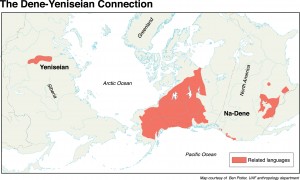It’s well-known that the American Indians and Siberian tribes share common ancestors; the ancestors of the first American Indians arrived in the Americas some 20,000 to 15,000 years ago via a land bridge that collected Alaska and Siberia, and after the land bridge was buried by water, they stayed on the new continent. However, according to a recent study, certain Native American tribes and ethnic groups in Siberia also share language traits. Scientists from my alma mater, Georgetown University, used a technique called linguistic phylogeny to discover a direct link between the Na-Dene language family of North America and the Yeniseian languages of Central Siberia. These findings reveal that the migration of peoples from central Asia to North America might not have been a one-way trip, with some people returning to their native home, taking their language back with them.
Back in 2012, DNA research revealed genetic markers that linked people living in Altai, in southern Siberia, with the American Indians. Because of thse wide spread of languages, and the fact that links still remain in Siberia, researchers have suggested that some of these migrants returned to their native Siberia. To further investigate this possible connection, scientists used a technique originally created to investigate evolutionary relationships between biological species, known as phylogenetic analysis. This involves creating a tree that represents relationships of common ancestry based on shared traits. Researchers used a linguistic version of this phylogeny, and discovered around 40 languages that diffused across Asia and North America.
Scientists began their study by coding a linguistic data set from each of the languages, and established relationships between this data. They then applied these links to the known migration patterns from Asia to North America. Their findings highlight an early dispersal of Na-Dene along the North American coast with a Yeniseian back migration to Siberia. According to study co-author Dr. Mark Sicoli, they found “substantial support” for the out-of-Beringia dispersal, adding to much more evidence for an ancestral population in Beringia before the land bridge was inundated by rising sea levels at the end of the last ice age. He also mentioned that although the researchers cannot conclusively determine the migration pattern just from these results, it does seem to indicate migration that may not have just been one-way. It also helps to demonstrate the usefulness of evolutionary modeling with linguistic trees for investigating these types of questions.
